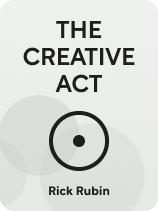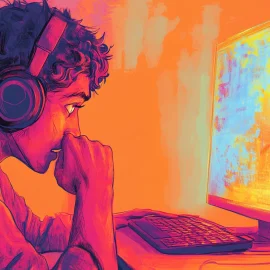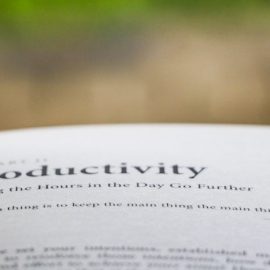

This article is an excerpt from the Shortform book guide to "The Creative Act" by Rick Rubin. Shortform has the world's best summaries and analyses of books you should be reading.
Like this article? Sign up for a free trial here.
How can you train your brain to switch into creative mode? Can you be creative even if you’re not feeling inspired?
Music producer Rick Rubin says that it’s important to build creative habits into your schedule rather than waiting for inspiration to strike. He explains that creativity is like a muscle that must be built up over time.
Here are Rubin’s suggestions for building your creative habits.
Build a Creative Habit
Rick Rubin writes that when you pay attention and stay open, you continuously gather information to serve as source material for later creative work. However, in order to do creative work, you must build creative habits.
To support your creativity, he suggests setting up daily or weekly rituals that facilitate your entry into an immersive creative state. He recommends creating a predictable space and time where your mind knows it’s time to switch into a creative mode. According to Rubin, these rituals could range from meditating before starting your work to establishing a routine time and place where you can be uninterrupted and focused.
| Building a Creative Habit Using The Artist’s Way If you aren’t sure where to begin building up a creative habit, The Artist’s Way by Julia Cameron provides a structured 12-week framework designed to unlock your creativity and help you develop a consistent artistic practice. The book introduces key tools such as morning pages and artist dates to facilitate this process. Morning pages are daily, stream-of-consciousness writings that help clear mental clutter and make way for creative thoughts. They are handwritten and completed first thing in the morning, focusing on whatever comes to mind without worrying about grammar or coherence. Artist’s dates are weekly solo excursions aimed at nurturing your inner artist. The goal is to engage in activities that spark curiosity and joy in order to refresh your creative well. Each chapter of the program focuses on different aspects of the creative process and provides practical exercises and reflections to help overcome creative blocks and cultivate a sustainable artistic practice. |
Rubin emphasizes the importance of consistency in these practices. It’s not just about setting aside time for creativity when you feel inspired; it’s about committing to these periods regularly, regardless of whether inspiration strikes immediately. This dedication helps in building a muscle for creativity, making it easier over time to enter into deep creative work.
(Shortform note: Your habits don’t have to be big to be impactful. In Atomic Habits, James Clear advises focusing on the consistency of the habit rather than its scale. By committing to a simple practice regularly, you leverage what he calls the “compound effect” where small changes accumulate into significant outcomes over time. This approach not only builds your creative muscle, as Rubin notes, but also embeds deep-seated habits that can sustain your creativity even when motivation is low.)
Furthermore, Rubin suggests minimizing distractions during these ritual periods. This could mean turning off your phone, using tools that block digital interruptions, or choosing environments where you’re less likely to be disturbed. The goal is to protect the sanctity of your creative time as much as possible. (Shortform note: Research suggests that on average people get distracted every three minutes, and then it takes over 23 minutes to refocus on the original task, which means that every distraction costs you additional time that could be spent on your creative work.)
At times focusing on your creative work will require you to fully immerse yourself in a project, giving your undivided attention to your project for extended periods and allowing it to consume your thoughts and energy. Rubin argues that when you immerse yourself, you develop a deeper connection with your work, potentially entering a flow state of effortless concentration and peak performance. This intense focus helps you overcome creative blocks and heightens awareness of nuances in your work. However, Rubin acknowledges the need to balance this deep engagement with rest as necessary.
| Four Strategies to Immerse Yourself in Creative Work In Deep Work, Cal Newport outlines four different strategies to integrate periods of focus, what he calls deep work, into your daily life. 1. The Monastic Philosophy involves scheduling deep work periods free from distractions, eliminating shallow obligations. It suits people who can largely control their schedules and focus on single, large projects for extended durations. 2. The Bimodal Philosophy involves dividing time into clearly marked chunks, some for deep work and the rest for shallow tasks. It is suitable for those who cannot fully engage in deep work at all times but can periodically dedicate significant blocks of time to it. 3. The Rhythmic Philosophy is about creating a regular schedule for deep work, making it a habit. It fits best with people who have structured schedules and are looking to integrate consistent, daily periods of deep work. 4. The Journalistic Philosophy, named because it fits the ability of journalists to switch into deep work whenever they have a free moment, is for those who can move into a state of deep concentration at a moment’s notice despite having an unpredictable schedule. Newport emphasizes that these philosophies aren’t mutually exclusive and can be combined or adapted depending on one’s circumstances, job requirements, and personal preferences. The key takeaway is to find a strategy that allows you to minimize distractions and dedicate time and energy to your creative work. |

———End of Preview———
Like what you just read? Read the rest of the world's best book summary and analysis of Rick Rubin's "The Creative Act" at Shortform.
Here's what you'll find in our full The Creative Act summary:
- Where creativity comes from and why it matters
- How to take inspiration from anywhere and everywhere
- A music producer’s advice for enhancing your creativity






